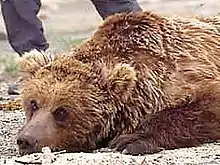Gobi bear
The Gobi bear (Ursus arctos gobiensis), known in Mongolian as the Mazaalai (Мазаалай), is a subspecies of the brown bear (Ursus arctos) that is found in the Gobi Desert of Mongolia. It is listed as critically endangered by the Mongolian Redbook of Endangered Species and by IUCN standards.[1] Based on a long-term DNA population demographic study, the population are existing with less than 40 adults in 2017,[2][3] and is separated by enough distance from other brown bear populations to achieve reproductive isolation. In 1959, hunting of the animal was prohibited in order to preserve the dying subspecies.[4]
| Gobi bear | |
|---|---|
 | |
| Scientific classification | |
| Kingdom: | Animalia |
| Phylum: | Chordata |
| Class: | Mammalia |
| Order: | Carnivora |
| Family: | Ursidae |
| Genus: | Ursus |
| Species: | |
| Subspecies: | U. a. gobiensis |
| Trinomial name | |
| Ursus arctos gobiensis Sokolov & Orlov,1920 | |
Behaviour and ecology
Gobi bears mainly eat roots, berries, and other plants, sometimes rodents; there is no evidence that they prey on large mammals. Small compared to other brown bear subspecies, adult males weigh about 96.0–138.0 kg (211.6–304.2 lb) and females about 51.0–78.0 kg (112.4–172.0 lb).[4] Gobi bears are the only bears that have evolved and adapted to living in such extreme hot desert climates.[3]
Genetic diversity
Gobi bears have a very low genetic diversity,[2][5] among the lowest ever observed in any subspecies of brown bear. Levels of genetic diversity similar to the Gobi bears have been reported only in a small population of brown bears in the Pyrenees Mountains on the border of Spain and France. The low genetic diversity is the result of Gobi Bears having a highly skewed sex ratio of males to females. There are about 21 males to 8 females. This the main cause of such low reproduction and population. In addition, research has shown there is a low number of alleles per locus in their DNA. This means that Gobi Bear DNA is fragile and therefore affects their reproduction.[3]
Research
Based on morphology, the Gobi brown bear has sometimes historically been classified as being of the same subspecies as the Tibetan blue bear. However, recent phylogenetic analysis has shown the Gobi bear and Himalayan brown bear[6] have a shared ancestry and both these populations are currently genetically isolated.[5] There are fewer than 40 Gobi bears left in the wild. The Gobi bears used to populate about 23,619 kilometers of land in Southwestern Mongolia. This number has decreased by nearly sixty percent due to the scarcity of food and water among the large creatures who feast on plants, fruits, and lizards. Climate change and mining are the two main threats to gobi bears and their extinction. If deserts start to get hotter and drier, it will make it difficult for the bears to find resources such as water and food. Mining is also just as important as it is causing damage to their environments. Some researchers have started to take investigations and they suggested that there are a few gobi bears left, as little as 25. The rough desert natural environment may make this species continued existence unstable. Gobi Bears will be more likely found in the Northern hemisphere, where their population is found to be healthier than the southern hemisphere due to a weaker conservation status. Gobi Bears are considered severely endangered as they are found to be isolated. [2]
See also
References
- "Ursus arctos: McLellan, B.N., Proctor, M.F., Huber, D. & Michel, S." IUCN Red List of Threatened Species. 2016-02-02. Retrieved 2021-11-10.
- Odbayar Tumendemberel; Michael Proctor; Harry Reynolds; John Boulanger; Amgalan Luvsamjamba; Tuya Tserenbataa; Mijiddorj Batmunkh; Derek Craighead; Nyambayar Yanjin; David Paetkau (2010). "Gobi bear abundance and inter-oases movements, Gobi Desert, Mongolia" (PDF). Ursus. 26 (2): 129–142. doi:10.2192/URSUS-D-15-00001.1. S2CID 86305718.
- Tumendemberel, Odbayar; Tebbenkamp, Joel M.; Zedrosser, Andreas; Proctor, Michael F.; Blomberg, Erik J.; Morin, Dana J.; Rosell, Frank; Reynolds, Harry V.; Adams, Jennifer R.; Waits, Lisette P. (August 2021). "Long‐term monitoring using DNA sampling reveals the dire demographic status of the critically endangered Gobi bear". Ecosphere. 12 (8). doi:10.1002/ecs2.3696. ISSN 2150-8925.
- "Gobi bear conservation in Mongolia" (PDF). July 2010. Retrieved 2016-03-19.
- Tumendemberel, Odbayar; Zedrosser, Andreas; Proctor, Michael F.; Reynolds, Harry V.; Adams, Jennifer R.; Sullivan, Jack M.; Jacobs, Sarah J.; Khorloojav, Tumennasan; Tserenbataa, Tuya; Batmunkh, Mijiddorj; Swenson, Jon E. (2019-08-13). "Phylogeography, genetic diversity, and connectivity of brown bear populations in Central Asia". PLOS ONE. 14 (8): e0220746. doi:10.1371/journal.pone.0220746. ISSN 1932-6203.
- Lan T.; Gill S.; Bellemain E.; Bischof R.; Zawaz M. A.; Lindqvist C. (2017). "Evolutionary history of enigmatic bears in the Tibetan Plateau–Himalaya region and the identity of the yeti". Proceedings of the Royal Society B: Biological Sciences. 284 (1868): 20171804. doi:10.1098/rspb.2017.1804. PMC 5740279. PMID 29187630.
Sources
- Chadwick, Douglas (April 2014). "Can World's Rarest Bear Be Saved?". National Geographic. Joe Riis (photography).
- "Gobi bear (Ursus arctos gobiensis)". Wildscreen Arkive. Archived from the original on 2008-09-19. Retrieved August 21, 2017.
- McCarthy, Thomas M.; Waits, Lisette P.; Mijiddorj, B. (2009). "Status of the Gobi bear in Mongolia as determined by noninvasive genetic methods". Ursus. 20 (1): 30–38. doi:10.2192/07GR013R.1. S2CID 86288105.
- Tumendemberel, Odbayar (2020). "Evolutionary history, demographics, and conservation of brown bears (Ursus arctos): filling the knowledge gap in Central Asia". Ph.D. dissertation. University of South-Eastern Norway.
Further reading
- Chadwick, Douglas (2017). Tracking Gobi Grizzlies: Surviving Beyond the Back of Beyond. Joe Riis and Douglas Chadwick (photography). Ventura, Cal.: Patagonia Books. ISBN 9781938340628. OCLC 984164885. Preview.